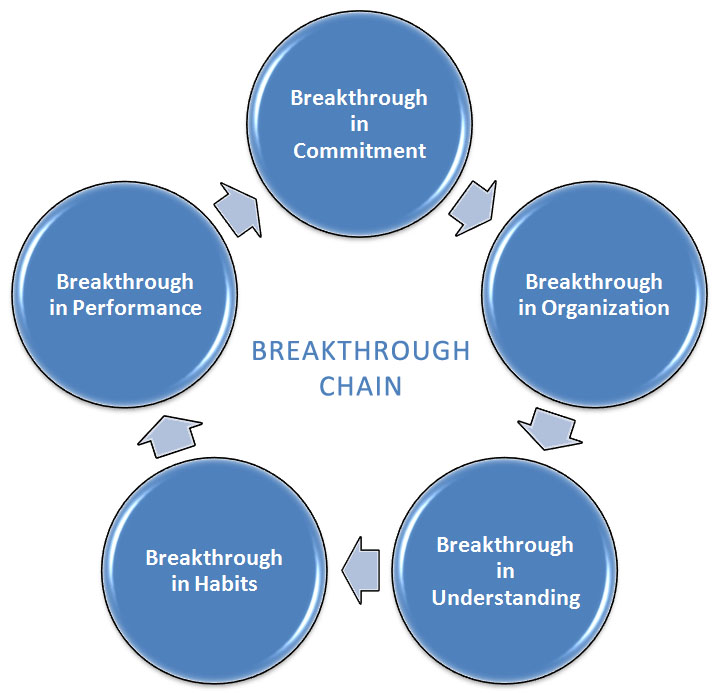Breakthrough Chain: The Elixir for Problem Solving
For Problem Solving there is a universal sequence of events by which we break out of old levels of performance into new ones. The details of this sequence are important. More significantly, the Breakthrough Chain engages the left- and right-brain.
The starting point is a Breakthrough in Commitment. The commitment we are referring to is that of Top Management. After all, in any organization people listen to what leaders say; however, they believe what leaders do. Leaders are largely focused on their Report Card – the Profit & Loss Statement. It is therefore important to express the opportunities for Problem Solving in the language of MONEY. Only then do leaders invest time in review. This is pure hard hitting left-brain.
 The next is a Breakthrough in Organization. In order to institutionalize Problem Solving we need a new organization structure. A structure that addresses Process Performance. Remember, functions are vertical. However, work flows horizontally along processes, across functions, to the customers. Problems seldom reside within functions. They reside on the functional fences, along a process. We therefore require a Quality Improvement Council of upper managers. Membership to the Council involves all key functions including operations, purchase, marketing, human resource, finance, etc. One of these upper managers serves as a full-time Quality Improvement Director, who is empowered to cross functional barriers. Supporting the Director is a Quality Improvement Cell that is populated with trainers, coaches, counselors, facilitators, administrators, etc. Then there are cross-functional project teams that are selected to solve chronic problems. They stay together for the life of a project, say six months. As you can see this is a process-focused organization. In order to be effective, project teams should include members from the human resource function. Their right-brain guides several team decisions.
The next is a Breakthrough in Organization. In order to institutionalize Problem Solving we need a new organization structure. A structure that addresses Process Performance. Remember, functions are vertical. However, work flows horizontally along processes, across functions, to the customers. Problems seldom reside within functions. They reside on the functional fences, along a process. We therefore require a Quality Improvement Council of upper managers. Membership to the Council involves all key functions including operations, purchase, marketing, human resource, finance, etc. One of these upper managers serves as a full-time Quality Improvement Director, who is empowered to cross functional barriers. Supporting the Director is a Quality Improvement Cell that is populated with trainers, coaches, counselors, facilitators, administrators, etc. Then there are cross-functional project teams that are selected to solve chronic problems. They stay together for the life of a project, say six months. As you can see this is a process-focused organization. In order to be effective, project teams should include members from the human resource function. Their right-brain guides several team decisions.
Project Teams then embark on a Breakthrough in Understanding. Teams are cross-functional and members of teams are very accustomed to blaming one another. However, they perform well when each member is committed to the mission assigned to the team by the Quality Improvement Council. Teams are coached by the Quality Improvement Cell on the four step Problem Solving methodology, as well as the relevant Quality Improvement Tools. They are also counseled by the Quality Improvement Cell on behavioral matters, while functioning as a team. Teams work extensively with data, i.e. facts, to analyze various hypotheses. This is a time consuming but rewarding part of the Breakthrough Chain. A Breakthrough in Understanding is best achieved with proficient application of left-brain tools coupled with right-brain empathetic listening.
In order to implement a solution, project teams are often confronted with resistance to change by operational people where the change is to be implemented. We need a Breakthrough in Habits. Quite frequently project teams are ill equipped to deal with behavioral issues. They are only accustomed to dealing with ‘things’. The challenge is that the stated reasons for resistance by individuals, and the actual reasons for resistance are very different. The actual reasons are the ‘unstated’ social consequences of the change. Will I become redundant? What will my family think? What will my neighbors think? Project teams cannot ignore the resistance. They have to define it and work with right-brain behavioral scientists provided by the Quality Improvement Cell.
Finally, we have a Breakthrough in Performance when the new methods are implemented. A project is closed when it is locked into the Quality Management System such as ISO 9001. This is classic left-brain work.
Realizing the importance of the subject, I am currently working on a digitized course that elaborates on the application of this Breakthrough Chain. It will be released in June and titled PROBLEM SOLVING.
